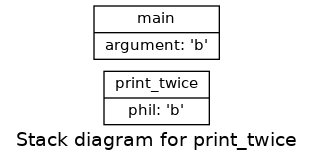3.11. Parameters and Variables are Local¶
Parameters and variables only exist inside their own functions. Within
the confines of main, there is no such thing as phil. If you try to use
it, the compiler will complain. Similarly, inside print_twice there is no
such thing as argument.
The value of argument in main is copied into the new variable phil
when print_twice is called.
The following code will show the output of the print_twice function. Notice that it is the argument ‘b’ that is outputted, not the variable ‘phil’.
Try This!
Make the following changes to the previous program:
Change the value of ‘phil’ before printing.
Print the value of ‘argument’ after
print_twiceis called.
Are the results what you expect?
Variables like this are said to be local. In order to keep track of parameters and local variables, it is useful to draw a stack diagram. Like state diagrams, stack diagrams show the value of each variable, but the variables are contained in larger boxes that indicate which function they belong to.
For example, the stack diagram for print_twice looks like this:

Keeping similar names separated from eachother in C++ is called scope – and is one of the most important and powerful concepts in C++ (or any programming language).
Whenever a function is called, it creates a new instance of that function (a new scope) and places it on top of the function call stack. Each instance of a function contains the parameters and local variables for that function. In the diagram an instance of a function is represented by a box with the name of the function in the first section and the variables and parameters inside. A instance of a function on the stack are stored in activation records.
In the example, main has one local variable, argument, and no
parameters. print_twice has no local variables and one parameter, named
phil.
- 1 local variable, 1 parameter
- A parameter would be located within the parentheses next to the function's name.
- 0 local variables, 1 parameter
- A parameter would be located within the parentheses next to the function's name.
- 2 local variables, 0 parameters
- Correct!
- 2 local variables, 1 parameter
- A parameter would be located within the parentheses next to the function's name.
Q-2: How many local variables and parameters does main have?
void print_hello_name (string name) {
cout << "Hello " << name << "!\n";
}
int main () {
string name1 = "Phil";
print_hello_name(name1);
string name2 = "Joe";
print_hello_name(name2);
return 0;
}
- 1 local variable, 1 parameter
- A local variable exists when a variable is declared within a function.
- 0 local variables, 1 parameter
- Correct!
- 2 local variables, 0 parameters
- A local variable exists when a variable is declared within a function.
- 2 local variables, 1 parameter
- A local variable exists when a variable is declared within a function.
Q-3: How many local variables and parameters does print_hello_name have?
void print_hello_name (string name) {
cout << "Hello " << name << "!\n";
}
int main () {
string name1 = "Phil";
print_hello_name(name1);
string name2 = "Joe";
print_hello_name(name2);
return 0;
}
Q-4: Whenever we make a function call, we create a(n) of that fucntion, which contiains the parameters and local variables for that function.
- 1 call
- hi( ) is called from multiple functions.
- 4 calls
- Correct!
- 2 calls
- hi( ) is called from multiple functions.
- 3 calls
- Two calls from one function are indeed two seperate calls.
Q-5: How many calls to hi are made during the exectuion of the entire program?
void hi() {
cout << "hiii !\n";
}
void print_greeting(){
hi();
cout<<"how are you doing today. \n";
hi();
}
int main () {
hi();
print_greeting();
hi();
return 0;
}
More to Explore
Scope from cppreference.com
Call statck from Wikipedia